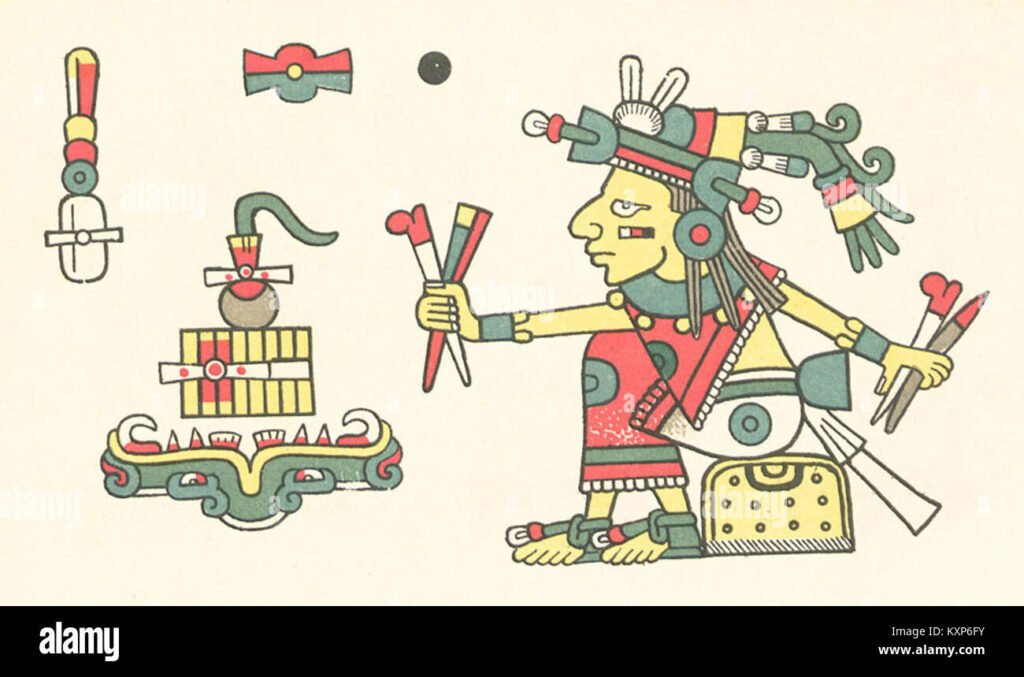In Aztec culture, maize was an essential crop that played a central role in the survival and prosperity of the civilization. To honor and seek the blessings of this vital crop, the Aztecs worshipped Centeōtl, the god of maize. Derived from the Nahuatl words “cintli” meaning “dried maize still on the cob” and “teōtl” meaning “deity,” Centeōtl held great significance in Aztec mythology. This article explores the various aspects of Centeōtl’s role in Aztec culture, including his parentage, depiction, importance, association with the calendar, rituals, and festivals, as well as the maize’s significance in Aztec religious practices and sacrifices.
Centeōtl: Parentage and Depiction
There are different accounts of Centeōtl’s parentage in Aztec mythology. Some sources state that he is the offspring of the earth goddess Tlazolteotl and the solar deity Piltzintecuhtli. On the other hand, some claim that Centeōtl is the child of the goddess Xochiquetzal, the deity of beauty, love, and fertility.
Centeōtl is often depicted as a young man with yellow body coloration, symbolizing the golden hue of ripe maize. Some experts believe that Centeōtl was formerly the maize goddess Chicomecōātl, who later became a separate deity in Aztec mythology.
Centeōtl’s Importance in Aztec Culture
The primary role of Centeōtl in Aztec mythology was as the god of maize. Maize was a staple food in the Aztec diet, providing sustenance to the population. As the god of maize, Centeōtl was believed to control the growth and abundance of the crop.
Aztec farmers performed rituals and offerings to Centeōtl to ensure a bountiful harvest. The deity was revered as the provider of nourishment and sustenance, reflecting the vital role that maize played in Aztec society.
Centeōtl’s Relationship with Chicomecōātl
Some scholars argue that Centeōtl and Chicomecōātl were originally the same deity but later became separate entities in Aztec mythology. Both Centeōtl and Chicomecōātl are associated with maize, but Centeōtl specifically represents the growing or living maize, while Chicomecōātl symbolizes the ripe or dead maize.
The distinction between Centeōtl and Chicomecōātl reflects the different stages of the maize life cycle, from planting to harvest. This differentiation highlights the intricate understanding the Aztecs possessed about the agricultural processes and the symbolic significance they attributed to each stage of maize cultivation.
Centeōtl in the Aztec Calendar
Centeōtl’s importance was also recognized in the Aztec calendar. In this system, he is associated with the number seven and is considered the Lord of the Day for days with that number. Furthermore, Centeōtl is the fourth Lord of the Night, highlighting his significance in the daily and nightly cycles of the Aztec worldview.
Rituals and Festivals Honoring Centeōtl
Planting of Young Maize Plants
The beginning of the year marked the start of the agricultural cycle for the Aztecs. They would plant young maize plants as a symbol of the goddess Chicomecōātl and to invoke Centeōtl’s blessings for a fruitful harvest. This ritual was accompanied by prayers and offerings to ensure the success of the maize crop.
Dances and Festivals
To express their gratitude for the growing maize, the Aztecs organized dances and festivals dedicated to Centeōtl and Mother Earth. These festivities involved music, singing, and communal participation. Female dancers, often bare-breasted, would perform in the maize fields to honor Centeōtl and ensure the success of the maize crops through their movements, which were believed to bring fertilization.
Maize in Aztec Rituals and Sacrifices
Importance of Maize in Religious Practices
Maize held immense significance in Aztec religious practices and rituals. The crop was considered a sacred gift from the gods, particularly Centeōtl and Chicomecōātl. Offering maize to the deities was believed to maintain the balance between the earthly and divine realms.
Ritual of Five Ripened Maize Cobs
One particular ritual involving maize was the picking of five ripened maize cobs, symbolizing the goddess Lady Chicomecōātl. The cobs were treated with reverence and placed in special corn baskets to symbolize the resting of maize spirits until the next harvest. This ritual highlighted the connection between maize, the gods, and the cycle of life and death.
Maize Sacrifices
Maize was commonly used as an offering in Aztec sacrifices. The ceremonial use of maize symbolized the reciprocal relationship between humans and the gods, with sacrifices serving as a way to sustain cosmic balance and ensure divine favor. Different parts of the maize plant, such as stalks and tassels, were offered in various rituals and ceremonies.
Conclusion
In Aztec mythology, Centeōtl, the god of maize, played a vital role in Aztec culture and religious practices. Maize was a staple crop crucial for the survival and prosperity of the Aztec civilization. Rituals and festivals were held to honor Centeōtl and express gratitude for the abundance provided by the growing maize. The Aztecs recognized the sacred nature of maize and its connection to the gods, offering it in religious ceremonies and sacrifices. The significance of Centeōtl in Aztec society exemplifies the deep cultural and spiritual importance of maize in Aztec mythology.
